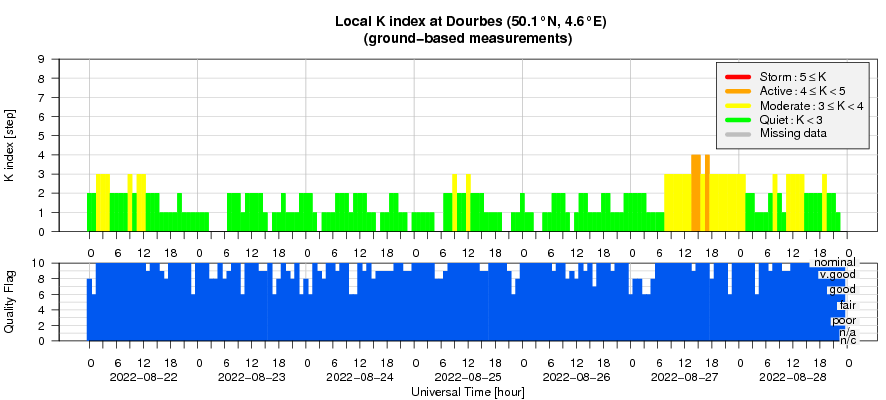- Table of Content
- 1.Review of sola...
- 2.Review of geom...
- 3.PROBA2 Observa...
- 4.The Internatio...
- 5.Noticeable Sol...
- 6.Geomagnetic Ob...
- 7.The SIDC space...
- 8.Action!
2. Review of geomagnetic activity
3. PROBA2 Observations (22 Aug 2022 - 28 Aug 2022)
4. The International Sunspot Number by SILSO
5. Noticeable Solar Events (22 Aug 2022 - 28 Aug 2022)
6. Geomagnetic Observations at Dourbes (22 Aug 2022 - 28 Aug 2022)
7. The SIDC space weather briefing
8. Action!
Review of solar activity
Flares
Solar activity reached high levels over the past week, with M7.2-class flare on 26 August 12:14 UTC from NOAA AR 3089 being the flare with the largest X-ray output. There were nine active regions present on the solar disc, most of them of small complexity and fairly stable. Of most interest were NOAA AR 3088 and 3089, which grew during the second part of the week and dominated the flaring activity.
Coronal Mass Ejections
Numerous Coronal Mass Ejections (CME) took place, which where either back sided or originated from NOAA AR 3088. The most noteworthy was the ICME on 27 August 02:12 UTC, associated with the M4.8-class flare 27 July 02:40 UTC (as well as type II and IV radio emissions and dimming). Said ICME arrived after the end of the past week.
Solar particles
A proton event was recorded when the greater than 10 MeV proton flux exceeded the 10 pfu threshold 27 August 11:53-21:45 UTC, as a response to the occurrence of the ICME of 27 August.
The greater than 2MeV electron flux was above the 1000 pfu threshold for the majority of the week, decreasing to below threshold from 27 August. Similarly, the 24h electron fluence started was at moderate levels for the majority of the week as well.
Review of geomagnetic activity
At the start of the week the solar wind parameters reflected waning high speed stream influences. After returning to background levels at the middle of the week, a possible arrival of a glancing blow on 27 August 08:36 UTC. There are multiple candidates for this, it is mostly believed it had been the CME 26 August 13:36 UTC for NOAA AR 3088.
Geomagnetic conditions reached active conditions at the time of the possible glancing blow of 27 August (NOAA Kp=Local K Dourbes 4).
PROBA2 Observations (22 Aug 2022 - 28 Aug 2022)
Solar Activity
Solar flare activity fluctuated from very low to moderate during the week.
In order to view the activity of this week in more detail, we suggest to go to the following website from which all the daily (normal and difference) movies can be accessed: https://proba2.oma.be/ssa
This page also lists the recorded flaring events.
A weekly overview movie can be found here (SWAP week 648). https://proba2.sidc.be/swap/data/mpg/movies/weekly_movies/weekly_movie_2022_08_22.mp4
Details about some of this week’s events can be found further below.
If any of the linked movies are unavailable they can be found in the P2SC movie repository here https://proba2.sidc.be/swap/data/mpg/movies/
Wednesday Aug 24
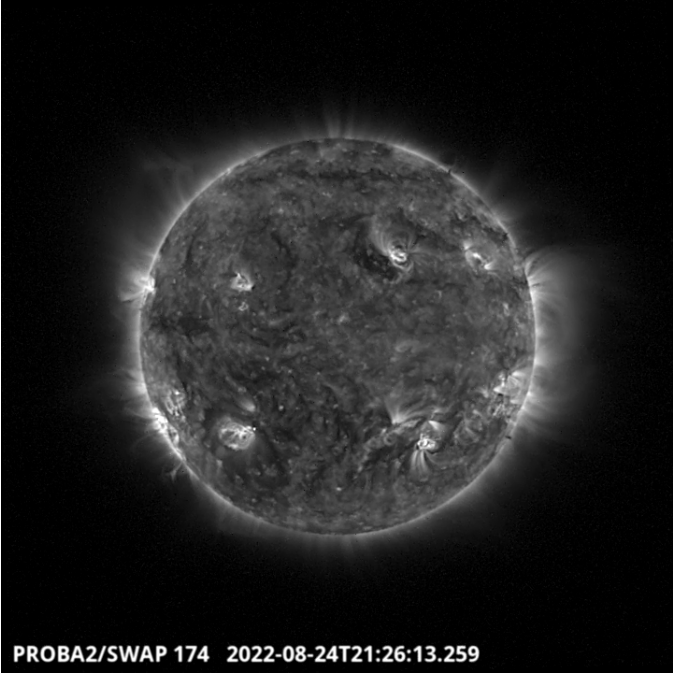
Until the end of the week, the active region NOAA 3086 is surrounded by a coronal hole in the
South-East hemisphere - SWAP image. Find a movie of the events here (SWAP movie) https://proba2.sidc.be/swap/data/mpg/movies/20220824_swap_movie.mp4
Friday Aug 26
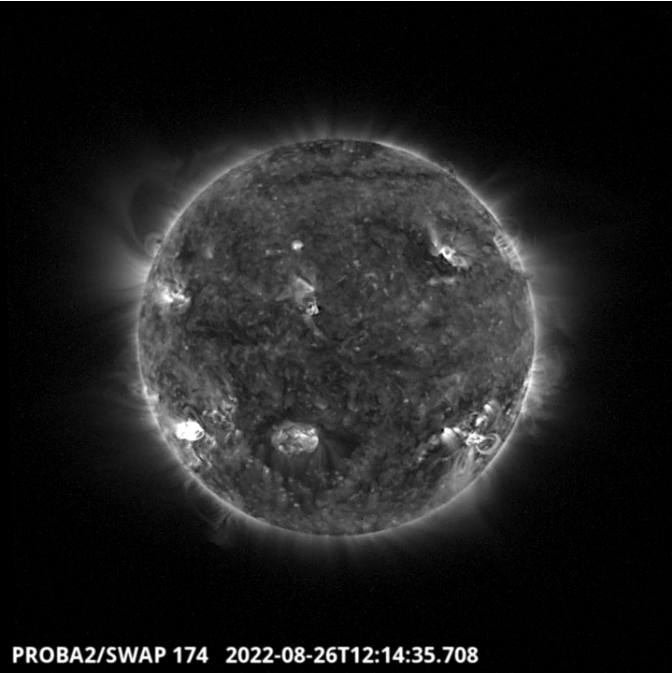
The largest flare of the week, an M7.2 flare, erupted in the NOAA active region 3089 - SWAP
image. Find a movie of the events here (SWAP movie) https://proba2.sidc.be/swap/data/mpg/movies/20220826_swap_movie.mp4
Saterday Aug 27
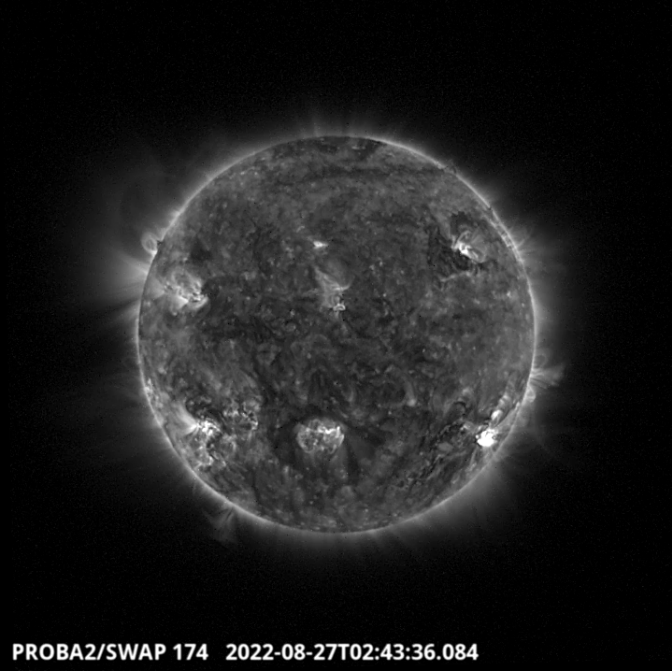
A shock wave produced by an M4-class flare was observed around 02:43 UT in the South West
quadrant.- SWAP image. Find a movie of the events here (SWAP movie) https://proba2.sidc.be/swap/data/mpg/movies/20220827_swap_movie.mp4
The International Sunspot Number by SILSO
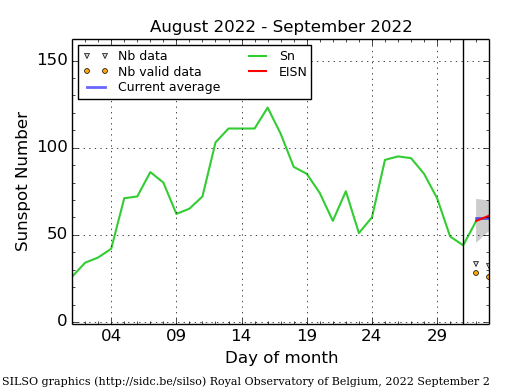
The daily Estimated International Sunspot Number (EISN, red curve with shaded error) derived by a simplified method from real-time data from the worldwide SILSO network. It extends the official Sunspot Number from the full processing of the preceding month (green line), a few days more than one solar rotation. The horizontal blue line shows the current monthly average. The yellow dots gives the number of stations that provided valid data. Valid data are used to calculate the EISN. The triangle gives the number of stations providing data. When a triangle and a yellow dot coincide, it means that all the data is used to calculate the EISN of that day.
Noticeable Solar Events (22 Aug 2022 - 28 Aug 2022)
| DAY | BEGIN | MAX | END | LOC | XRAY | OP | 10CM | TYPE | Cat | NOAA |
| 25 | 1939 | 1951 | 2002 | M1.8 | 3088 | |||||
| 25 | 2321 | 2327 | 2332 | S20E61 | M1.0 | 1N | 3089 | |||
| 26 | 1041 | 1055 | 1105 | S22E52 | M2.1 | 1N | 22 | 3089 | ||
| 26 | 1208 | 1214 | 1221 | S22E51 | M7.2 | 1B | 22 | 3089 | ||
| 26 | 1224 | 1231 | 1238 | M5.3 | 22 | 3089 | ||||
| 27 | 0152 | 0240 | 0305 | S19W58 | M4.8 | SF | 130 | II/1IV/1 | 21 | 3088 |
| 27 | 1129 | 1138 | 1143 | S28W66 | M1.2 | SN | 21 | 3088 | ||
| 27 | 1513 | 1525 | 1530 | S28W71 | M1.1 | SF | 21 | 3088 | ||
| 27 | 1545 | 1558 | 1621 | M1.8 | CTM/1 | 21 | 3088 | |||
| 28 | 0047 | 0134 | 0138 | M1.4 | 21 | 3088 | ||||
| 28 | 1548 | 1619 | 1646 | S28W80 | M6.7 | SF | III/2VI/1IV/1 | 21 | 3088 | |
| 28 | 1820 | 1832 | 1850 | M4.6 | 21 | 3088 |
| LOC: approximate heliographic location | TYPE: radio burst type |
| XRAY: X-ray flare class | Cat: Catania sunspot group number |
| OP: optical flare class | NOAA: NOAA active region number |
| 10CM: peak 10 cm radio flux |
The SIDC space weather briefing
The Space Weather Briefing presented by the forecaster on duty from Aug 21 to 28. It reflects in images and graphs what is written in the Solar and Geomagnetic Activity report: https://www.stce.be/briefings/20220829_SWbriefing.pdf
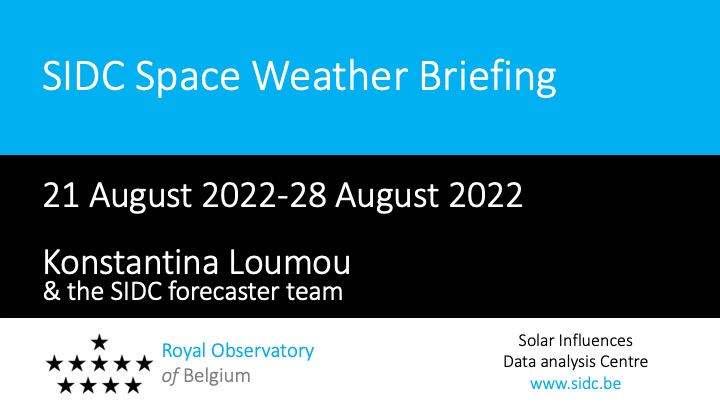
If you need to access the movies, contact us: stce_coordination at stce.be
Action!
Check out our activity calendar: activities and encounters with the Sun-Space-Earth system and Space Weather as the main theme. We provide occasions to get submerged in our world through educational, informative and instructive activities.
If you want your event in our calendar, contact us: stce_coordination at stce.be
* September 24-25 Space Pole Open Days, Brussels, Belgium
* October 11, Webinar: Putting the FAIR principles into practice: the journey of a GNSS data repository, GNSS@Royal Observatory of Belgium
* October 24-28, 18th European Space Weather Week, Zagreb, Croatia
* November 21-23, Space Weather Introductory Course - onsite, by the STCE, Brussels, Belgium - fully booked
* December 5, 6, 8, 9, Space Weather Introductory Course - online, by the STCE, zoom - fully bookes
Check: https://www.stce.be/calendar

